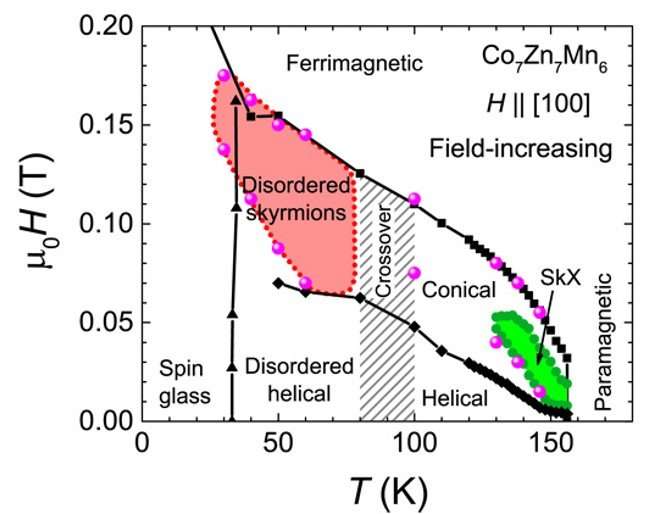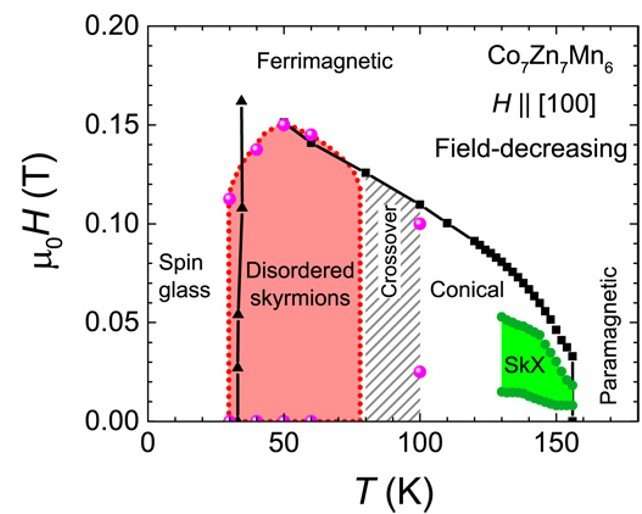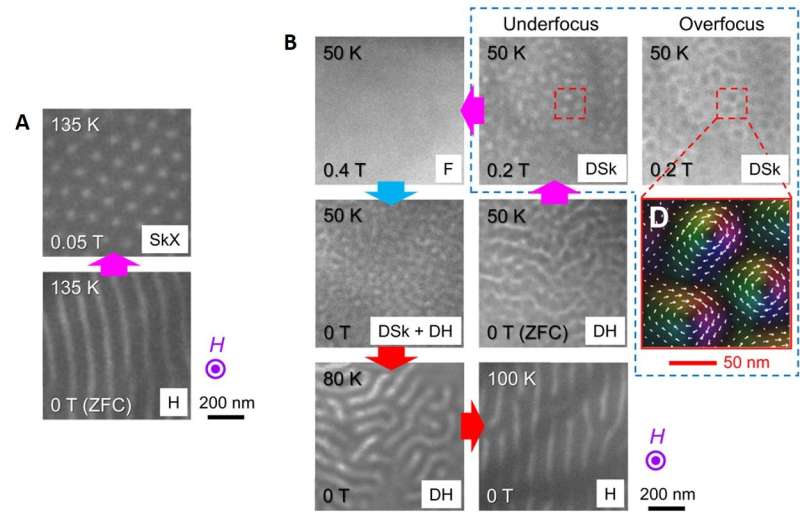September 27, 2018 feature
Disordered skyrmion phase stabilized by magnetic frustration in a chiral magnet
![Zero-field magnetic phase diagram with temperature (T) and Mn composition (x) connecting Co10Zn10 and β-Mn according to (Co0.5Zn0.5)20−xMnx. A spin glass phase is found to exist at low temperatures and across a wide-range of x. For 3< x <7, the spin glass phase invades the helical phase, displaying a microscopic existence of the two states. The diagram inset shows a schematic of a β-Mn-type structure viewed along the [111] axis. T is temperature and x is the Mn composition. Credit: Science Advances, doi: 10.1126/sciadv.aar7043 Disordered skyrmion phase stabilized by magnetic frustration in a chiral magnet](https://scx1.b-cdn.net/csz/news/800a/2018/disorderedsk.jpg)
In classical mechanics, particles are represented by point masses or rigid bodies, and in field theory by wave-like excitations or vibrations. Magnetic skyrmions are small, vortex-like spin textures of topological origin found in a variety of magnetic materials, and characterized by long lifetime. They were first discovered in 2009. In chiral magnets, skyrmions and skyrmion crystals (SkX) show unique physical properties due to their stability at ultralow current density. Explaining the stability of such particles is nontrivial; however, the particles can be described as topologically protected against small perturbations and decay. These properties can be advantageous for potential applications of skyrmions as information carriers in magnetic memories for storage and processing. Skyrmions are formed in magnetic systems via a variety of mechanisms, some of which work together.
The mechanisms include the Dzyaloshinskii-Moriya interaction (DMI), frustrated exchange interaction, long-ranged magnetic dipolar interactions and four-spin exchange interactions, characterized by the diameter of the resulting skyrmion structure. For instance, chiral magnets with an antisymmetric interaction between the spins, known as the DMI, can form a triangular-lattice skyrmion crystal (SkX). Specifically, a finite DMI can arise due to broken inversion symmetry at interfaces of thin film layers or in bulk materials with chiral or polar structures.
In metallic systems, the existence of a chiral interaction was first demonstrated for disordered alloys. Skyrmions based on DMI were recently observed in Co-Zn-Mn alloys with the β-Mn-type chiral cubic structure, where the unit cell contains 20 atoms distributed across two inequivalent crystallographic sites. Now writing in Science Advances, Kosuke Karube and co-workers report the intermediate composition system Co7Zn7Mn6 as a unique host of two disconnected, topological skyrmion phases.

According to the report, one phase is a conventional skyrmion crystal stabilized by thermal fluctuations and restricted to exist just below the magnetic transition temperature (Tc), whereas the second phase is a novel three-dimensionally disordered skyrmion crystal phase that is stable well below Tc. The stability of this new disordered skyrmion phase was attributed to a cooperative interplay between the chiral magnetism with the DMI and the frustrated magnetism inherent to the β-Mn structure.
Skyrmions can be typically observed by small angle neuron scattering (SANS) and with microscopy techniques in real space. In chiral magnets, the effect of DMI gradually twists ferromagnetically coupled moments to form a helical ground state. In the study, the authors reported similar behaviour for a spin glass phase symptomatic of frustrated magnetism existing at low temperatures across a wide range of Mn compositions for Co-Zn-Mn alloys. The glass phase invaded the helical ground state to display typical metal-insulator transition indicating the microscopic co-existence of the two phases. To investigate the mechanistic influence of frustrated exchange interactions on the helical and topological spin structures, the authors focused on Co7Zn7Mn6 with Tc ~ 160 K and spin glass transition temperature Tg ~ 30 K. In the study, further measurements were performed of SANS, magnetization, alternate current (ac) magnetic field susceptibility and Lorentz transmission electron microscopy (LTEM) of the material.
The scientists summarized their findings in a phase diagram to show two distinct, equilibrium skyrmion phases. A conventional SkX phase slightly below Tc and a novel disordered skyrmion phase (DSK) phase near Tg.

In the field decreasing process that was subsequently observed, the new phase was quenched as a metastable state down to zero field cooling (ZFC). The findings in the study were substantiated by summarizing the relation between the real-space magnetic structures with the corresponding SANS patterns recorded in the study.
Real-space observations were conducted with Lorentz transmission electron microscopy (LTEM) measurements. In the field-increasing run at 135 K from zero field cooling (ZFC), the transition from a helical state (H) to a conventional SkX state was observed. At 50 K, a disordered helical state was observed, and in contrast at a magnetic field of 0.2 T, several closed, dot-like objects assigned to skyrmions were clearly observed. The observation of DSKs in the LTEM images was explained as an inherent feature of the material, consistent with the corresponding SANS patterns observed in the study.

The study collectively investigated the possible origin of the novel DSK phase, since skyrmion phases are generally stabilized by quantum critical or thermal fluctuations. Two types of fluctuations were found in the present study to promote topological phase stability in Co7Zn7Mn6, including thermal fluctuations and frustration-induced fluctuations. In this way, the skyrmion governed by DMI demonstrated a novel mechanism for topological stability in Co7Zn7Mn6.
More information: Kosuke Karube et al. Disordered skyrmion phase stabilized by magnetic frustration in a chiral magnet, Science Advances (2018). DOI: 10.1126/sciadv.aar7043
Journal information: Science Advances
© 2018 Phys.org





















